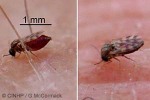Cook Islands Biodiversity Database
Species Page
Culicoides belkini
No-see-'em Biting-Midge
Multimedia & Additional Resources
| Type | Description | Download |
| Adult female - two views | 24KB | |
| Illustration of head and wing-pattern | 70KB |
General Information
Cook Islands Distribution
| Southern Group: Present Makatea: Present | ||||||||
RR |
MG |
AT |
MK |
MT |
AK |
PL |
TK |
MN |
- |
- |
- |
- |
++ |
+++ |
- |
- |
++ |
| Northern Group: - | |||||
TN |
MH |
RK |
PK |
NS |
SW |
- |
- |
- |
- |
- |
- |
Scientific Taxonomy
Culicoides belkini Wirth & Arnaud 1968
TAXONOMY: ANIMALIA; ARTHROPODA; ATELOCERATA; HEXAPODA; INSECTA; PTERYGOTA; Diptera; CERATOPOGONIDAE
More Information
SIGNIFICANCE NOTES -
NEGATIVE SIGNIFICANCE: Pest to people, toxic bite - serious. Comments: NBSAP - Aitutaki (4 of 10 animal pests), NBSAP - Mitiaro (1 of 9 animals). Female gives a painful bite, mainly around dusk and throughout the night. In the Cook Islands it is not a disease carrier. Repellants are effective. See "General Note" for more details.
IDENTIFICATION: Minute insect, to 1.5mmBL. HEAD large eyes; proboscis relatively short, mouthparts with terminal teeth. THORAX dark brown. ABDOMEN brown, plump. WING 1.1x0.5mm, dark brown with pale patches (see images); halter knob brownish. BITE usually a sharp pain, develops into a red spot (1cmØ) associated with intense itching and burning sensations. Can take 2 weeks to completely disappear.
GENERAL NOTE: The No-see-'em Biting-Midge was probably a rare endemic of the Society Islands until coastal developments, such as airports, increased its habitat making it relatively common. It was first reported in Borabora in 1960, Faaa on Tahiti in 1962, and Tetiaroa 1967, various Tuamotu 1968. The real identification of 1940 specimens from Samoa, reported as this species, remain in doubt, and no biting problem has been reported there. Thus we here consider the species an endemic of French Polynesia.
In the Cook Islands it was first reported on Aitutaki in 1964, Manuae 1969, and Mitiaro mid-1970s. We will follow the scientific reports of the 1960s concluding that it was introduced to Aitutaki by airplane from Borabora. Its movement to Manuae and Mitiaro was presumably by boat.
Of the six biting midges found in the area from Fiji to the Marquesas, Culicoides belkini is the only species that bites people. There is another such pest biting midgge in Palau in Micronesia.
Adults live 6-12 months, and the life cycle (egg-to-adult) takes about four weeks. The female needs a mammal-blood meal before she lays each batch of eggs, probably about a week apart. The eggs, larvae and pupa are found in brackish water or waterlogged sand, often at the seawater-freshwater interface. Control means include draining brackish ponds, and physical structures turn brackish areas into freshwater or raise the salinity to more than 50% that of seawater.
Females seek blood at dusk and throughout the night, and can fly about one kilometre when the air is still, and are attracked by lights. The bite often gives an immediate needle-like pain, and is followed by itching and burning sensations. In the Cook Islands the No-see-'em Sandfly does not carry any disease. Repellants and mist-blown insecticides are effective.
Vouchers & References
Vouchers:
None Recorded.
References:
Special Reference: Wirth & Arnaud (1969). Pacific Insects No.11: 507-520, text & illustrations.
Data Update History (information):
zTX, zB02, zM02, zD02
Web Resources
Citation Information
McCormack, Gerald (2007) Cook Islands Biodiversity Database, Version 2007.2. Cook Islands Natural Heritage Trust, Rarotonga. Online at http://cookislands.bishopmuseum.org. ![]()
Please refer to our use policy.

